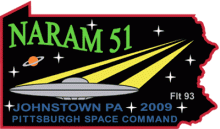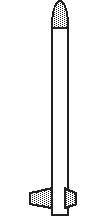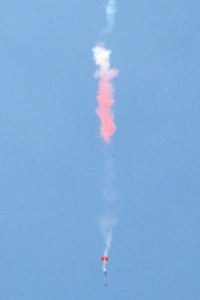 |
NARAM-51 Event Tips Pages (draft) |
 |
|
|
|
|
|
|
|
|
|
|
|
|
|
|
|
|
|
|
|
|
For NARAM-51, the Altitude event is for B engine class. Altitude models can be staged, though this is quite difficult to do based on the current choice of contest certified engines. The model does not have to use a specific recovery device, it just needs to make a safe recovery. Most people use a small streamer for recovery of Altitude models. For the full rules for this event, please see the Altitude Rules on the NAR web page. Scoring - For B Altitude, the scoring is best SINGLE qualified flight altitude of two flights allowed. The model does not have to be returned unless requested by the officials (in case an ejected engine is suspected, for example). Design considerations - Designing and building a low-drag model that can successfully fly as high as possible and be tracked to that altitude.
For some more tips, check out Lee Jame's TCC page for Altitude Events. Plans for an 18mm Streamer model to convert: ASTRE PD/SD model plan by Jeff Vincent, and DarkStar PD/SD plan by Mark Talkington. Fortunately, ASP , QCR, and Fliskits have some 18mm Streamer Duration model kits available. Also, Apogee, Pratt Hobbies, and Estes have kits that can be sutiable to fly in B Altitude. Plans and kits are listed further down this page. If the old Apogee B7 motors (13mm diameter) were still contest certified, the optimal designs for this event would look much different. As staging 13mm A's is a very difficult choice, this narrows the practical options to a single staged 18mm B engine, which in this case pretty much comes down to the Estes B6-6. A key to any altitude event is building the model to fly straight and true. Work towards attaching all of the fins so they are straight and parallel to the body. This should translate to a straight boost, with minimal wobbling that would hurt the altitude. A good finish is important for altitude models. Don't overdo it though, it helps to keep the model lighte. As weight goes up, peak altitude goes down. Try to focus on light weight designs and not build too heavy.
|
|
Model Plans & Kits |
Designer |
Notes |
|
DarkStar PD/SD plan (18mm) (WOOSH website) |
plan by Mark Talkington |
PDF file of an 18mm model suitable for Streamer and Parachute Duration |
|
ASTRE PD/SD model plan (NAR website) |
plan by Jeff Vincent |
PDF file of 13mm and 18mm PD & SD models |
|
ASP "Streamer Duration" Kit #KSDT - 18 (18mm) |
ASP (Aerospace Specialty Products), Andy Jackson |
Good competitive kit for 18mm engines. |
|
QCR - "Straight Up I " Parachute/Streamer Duration kit for 18mm engines |
QCR - Qualified Competition Rockets, Ken Brown |
Good competitive kit for 18mm engines. |
|
FlisKits - Cougar 660 (18mm) Streamer Duration kit. |
Jim Flis |
18mm kits for Streamer Duration |
|
Apogee "Blue Streak" sport model kit |
Not designed for contest use, but can be a decent model. |
|
|
ESTES- "Wizard" sport model kit. |
Not designed for contest use, but can be a decent model when modified to use a good contest streamer. |
|
|
Doug Pratt |
A sport model kit that looks and flies like a contest model. |
return to top

